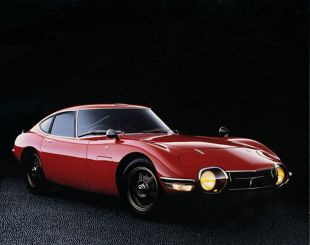
Toyota's first supercar. A total of 337 copies were produced.
 3 world records. 10 international records. Only 337 copies. The legendary Toyota 2000GT is one of the most charming cars in automotive history. The best examples today are worth more than a million dollars and evoke emotions among the owners of the world's leading collections.
3 world records. 10 international records. Only 337 copies. The legendary Toyota 2000GT is one of the most charming cars in automotive history. The best examples today are worth more than a million dollars and evoke emotions among the owners of the world's leading collections.
 The idea for the first Japanese Gran Turismo (GT) was born in late 1963. A few months earlier, authorities in Mie Prefecture (Honshu) opened Japan's first Suzuka track, where Grand Prix races were held.
The idea for the first Japanese Gran Turismo (GT) was born in late 1963. A few months earlier, authorities in Mie Prefecture (Honshu) opened Japan's first Suzuka track, where Grand Prix races were held.
Toyota's head of development, Jiro Kawano, was not only a passionate sportsman, but also a pragmatist, for whom the new facility was a dream place to test cars. Toyota debuted at the 1963 Japanese Grand Prix with the Publica (C2 up to 700 cc), Corona (C3 up to 5 cc) and Crown (C1600 up to 3 cc) at the Suzuka Circuit.
In the early 60s, Toyota produced mainly city and compact cars. Few have opted for larger models like the Crown. Today, the Land Cruiser is associated with luxury, back then it was considered the workhorse of a farmer, forester or geologist. The 280A project was supposed to break the stereotype of a solid, but unremarkable car for everyone and become Toyota's ticket to the automotive super league.
The editors recommend:
Penalty points online. How to check?
Factory installed HBO. This is what you need to know
Used middle class car under PLN 20
Sporting successes and speed records would make this most difficult task easier. Cavanaugh has challenged Jaguar, Lotus and Porsche, who have found success both on the race track and in the sales charts in the key US market. Domestic competitors also did not go unnoticed in Toyota. It's no secret that Datsun plans to attack the high-performance segment with the Prince Skyline GT. The 280A project was a demonstration of the technical capabilities of Toyota as an innovative company that implements bold concepts. The Japanese manufacturer intended to compete effectively with the world leaders in the automotive industry. Other benefits were also evident in the form of a positive image and the possibility of accelerated improvement of brand vehicles in accordance with the Kaizen philosophy. The CEO of the company, Eiji Toyoda, accepted Kawano's idea: now the 280A project has been put into practice.
The power of innovation
 The work of the five-person team began in May 1964. Six months later, Satoru Nozaki and Shihomi Hosoya presented a 1:5 scale model of a two-seater coupe. The low, only 116-centimeter body with harmonious lines made an electrifying impression, including. thanks to electrically raised headlights and was associated with the design of the best Italian stylists. The aerodynamic drag coefficient Cx 0,28 even today, after half a century, can be considered excellent. The bodywork was made by hand from aluminum sheet. Unusually, because the battery is in a storage compartment behind the front wheel arch. This solution has already been used by the British Bristol since the 404. The independent suspension and chassis with a central longitudinal frame were designed by Shinichi Yamazaki. For the first time in a Japanese car, disc brakes manufactured by Sumitomo under license from Dunlop are used on each wheel. An absolute novelty among the manufacturers of the Land of the Rising Sun was a mechanical, 5-speed, extremely accurate Toyota gearbox with overdrive and wheels cast from an ultra-light magnesium alloy. However, the prototypes used Italian imported Borrani spoked rims with a center nut. The list of hundreds of innovative solutions is rounded off by Dunlop SP 41 radial tires in size 165 HR15. Until now, "Made in Japan" cars have been running bias-ply tires.
The work of the five-person team began in May 1964. Six months later, Satoru Nozaki and Shihomi Hosoya presented a 1:5 scale model of a two-seater coupe. The low, only 116-centimeter body with harmonious lines made an electrifying impression, including. thanks to electrically raised headlights and was associated with the design of the best Italian stylists. The aerodynamic drag coefficient Cx 0,28 even today, after half a century, can be considered excellent. The bodywork was made by hand from aluminum sheet. Unusually, because the battery is in a storage compartment behind the front wheel arch. This solution has already been used by the British Bristol since the 404. The independent suspension and chassis with a central longitudinal frame were designed by Shinichi Yamazaki. For the first time in a Japanese car, disc brakes manufactured by Sumitomo under license from Dunlop are used on each wheel. An absolute novelty among the manufacturers of the Land of the Rising Sun was a mechanical, 5-speed, extremely accurate Toyota gearbox with overdrive and wheels cast from an ultra-light magnesium alloy. However, the prototypes used Italian imported Borrani spoked rims with a center nut. The list of hundreds of innovative solutions is rounded off by Dunlop SP 41 radial tires in size 165 HR15. Until now, "Made in Japan" cars have been running bias-ply tires.
6 instead of 8
The main problem was the choice of the power unit. Initially, the option of using an 8-liter 115-cylinder engine with 2,6 hp was considered. from the flagship Crown Eight, but in January 1965 the YX122 project was commissioned by Yamaha Motor Co. Ltd. The base was a new 2-liter 6-cylinder in-line (designation 3M) engine from the Toyopet Crown MS50. As part of the modification, a double camshaft was used, a new aluminum cylinder head with 4 valves per cylinder and hemispherical combustion chambers. Fuel for the engine was supplied by 3 Mikuni-Solex or Weber 40DCOE carburetors. After tuning Yamaha, the power increased to 150 hp. at 6600 rpm. In the mid-60s, the average unit of a similar displacement usually developed 65–90 hp. After successful dynamometer testing, the prototype was subjected to killer testing from the spring of 1965 by factory driver Eizo Matsuda and the aforementioned Shihomi Hosoya of the design department.
How to check penalty points online?
Surprise the world
October 29, 1965 Harumi Shopping Center in Tokyo. The 12th edition of the showroom is just beginning. This is a must for every Japanese producer. At the Toyota show, the first 2000GT rideable prototype (280A/I) glows white and chrome. Visitors are amazed, because the company's cars have not yet impressed with their appearance and shocked with their characteristics. Earlier, when a photo of one of the prototypes was published in the press, a journalist from the British magazine The Car signed it with the caption: “This is not a Jaguar. It's Toyota! Camera shutters are cracking, flashes are reflected from the paintwork, journalists are delighted. The 2000GT is a true Grand Turismo! The interior is sporty, elegance is muted: the tachometer, oil pressure gauge and other indicators are placed in tubes, deep "buckets" trimmed with leather upholstery. The Nardi wooden steering wheel is mounted on a telescopic safety stand. The cockpit is covered with matte plastic and rosewood veneer. The console is equipped with a radio receiver with automatic wave search. In the trunk is a set of 18 tools in a case with the inscription Toyota. There are 10 colors to choose from, including 4 metallic colors, but 70% of customers will order a car in Pegasus White.
Toyota Warriors
On May 3, 1966, the 3rd Japanese Grand Prix started at the Suzuka circuit. During a briefing with the players, Jiro Kawano reminds that after 2 years, it's time for the whole team to try. For the Japanese, honor is not just an empty word, but the term "fighting spirit" is an abstract phrase. Racers, like samurai emperors, sincerely swear to fight for victory. Toyota unveiled 2000GT prototypes. Behind the wheel of the red #15 was the legendary Shihomi Hosoya, a designer and designer with a military soul. Let's add: a fighter shining with the glory of the winner, because on January 16, 1966 he won the extremely difficult 500-kilometer race at the Suzuka circuit in the sensational Toyota Sports 800 with a 45-cylinder boxer engine with a capacity of 2 hp. . He won by covering the distance on a single tank of fuel as competitors from the Datsun and Triumph teams wasted precious seconds refueling. Another experienced Toyota driver, Sachio Fukuzawa, starts from number 17. During the race he will be replaced by Mitsuo Tamura in the cockpit of a silver Toyota. One of the cars has experimental fuel injection, the rest have 3 Weber carburetors. Engine power 200–220 hp The cases are made of aluminium.
The Grand Prix has a dramatic turn. At one point, Hosoya seems to bounce as his car pirouettes and lands on the grass, but after a while, number 15 continues to race. Ultimately, the Prince R380/Brabham BT8 wins out, but the 2000GT's debut is hugely successful. Hosoya crosses the finish line third. Behind Toyota on the beaten track there will be dangerous rivals, incl. Datsun Fairlady S and Porsche 906 prototype! Jaguar E-Type, Porsche Carrera 6, Ford Cobra Daytona and Lotus Elite drivers also recognized the advantage of the Toyota team. After the race, engineers dismantle the cars for the main factors and analyze the wear of the elements. Kaizen obliges: project prototypes are constantly improved so that the serial Toyota 2000GT (factory code MF10) becomes a fast and absolutely reliable car. It is worth adding that the red prototype with the number 15 (car 311 S) has not survived to this day, having been destroyed during the tests. Since 2010, the Shikoku Automobile Museum has been presenting its replica.

